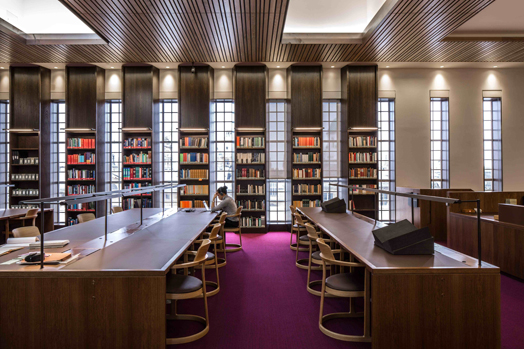Compiled by Pari Syal
Photography: Ben Bisek;
courtesy Wilkinson Eyre Architects
.jpg) |
| . |
Oxford
University’s Weston Library renovation by leading architectural practice
Wilkinson Eyre focuses on safeguarding its vast and unique
collection of books and manuscripts...
Part of the
University’s world famous Bodleian Library, the Grade Il listed building
(formerly the New Bodleian), which was originally designed by Sir Giles Gilbert
Scott in the 1930s, stands anew finely equipped with a revised layout that has
removed the upper floors and replaced them with a dedicated reading room and
suite equipped with the latest research facilities. Likewise, the three- storey
stacks underground have been partially rebuilt and upgraded to modern archival standards,
and for the first time, controlled shafts of daylight permeate into the heart
of the building.
The
much-anticipated project has
created high-quality storage
for the Libraries’ valuable special collections,
which have been preserved for scholarship; developed the Libraries’ space for
the support of advanced research; and
has expanded public access to its great treasures via its
new exhibition galleries and a lecture theatre.
By opening up
the building to promote its special collections to the wider public, Wilkinson
Eyre has also addressed the building’s identity and related it more closely to
its immediate context by improving its perception and approach.
The architects
have started by connecting the library to the core Bodleian buildings: the new
Blackwell Hall is a publicly accessible, top-lit 13.5 metre high space that forms
the heart of the new library and features a café, information desk, a 16th
Century tapestry map (the Sheldon Tapestry) and a 15th Century gateway on
permanent loan from the V&A Museum.
The gateway
originally led to the garden of the historic Dorner family’s estate at Ascott
Park in Oxfordshire and was the only surviving structure following a fire in
1662. With the support of Oxfordshire Buildings Trust, the incorporation of
this gateway sees this grand piece of architecture returned to its original
home county in a new and unique setting, emphasising the theme of old and new
that runs through the entire building.
Blackwell Hall
opens up to two new exhibition spaces and a café, creating an enticing
proposition and welcoming experience for the general public, being directly
accessible through the new public entrance on Broad Street.
Exhibition
galleries have been added, along with other new facilities including a Digital
Media Centre, a Visiting Scholars Centre, a lecture theatre, and a suite of
seminar rooms to enable teaching and master-classes based on the library’s
special collections. These facilitate contemporary research practices and
techniques, supporting the library’s academic users, as well as enabling public
interaction with the library’s collections and treasures.
Whilst carrying
out the refurbishment and enhancement of this iconic library building,
Wilkinson Eyre has addressed major challenges with its infrastructure and
upgraded its facilities without compromising the building’s charming, historic
character. Scott’s original design replicated the typology of an Oxford
University college but with the traditional quadrangle space in the centre
occupied by an 11-storey book stack based around a large complex of unprotected
steel framework.
The highest
storeys of Scott’s original building, hidden during the 1960s by an extension,
have been re-instated and restored to include a new reading room boasting the
best views of the city’s iconic spires. The slit windows arranged in rows,
through which the spires are visible, are a signature Scott feature and a key
expression of the building’s 1930s character. Scott was renowned for embracing
modern building techniques and glazing in the building, including the slit
windows, were the first large-scale use of anodised aluminium in the UK.
.jpg) |
| . |
Particular care
has been taken to restore and match Scott’s high-quality craftsmanship and
original materials palette. From stone to metal to plaster, as well as joinery
and furniture, Wilkinson Eyre’s attention to proportion, materiality and light
in the new spaces gives rise to a quiet, scholarly gravitas emanating from this
previously unloved building. 140 tonnes of salvaged stone was re-used in the
new façades and external stonework — including two angels holding the
University of Oxford coat of arms, and the bust of Bodleian Libraries’ founder
Sir Thomas Bodley above the King George VI door — has been expertly cleaned and
repaired. The ‘tour de force’ of original joinery is the main reading room,
including a decorative, inlaid timber ceiling, which mimics Native American and
African designs in a stylised Art Deco manner, and has been cleaned and
restored to its original splendour. New bespoke additions such as shelving and
tables have been designed and specified sympathetically.
Situated
opposite Nicholas Hawksmoor’s iconic Clarendon Building and Christopher Wren’s
exquisite Grade I listed Sheldonian Theatre, the library renovation is at the
heart of an ambitious period of renewal of the Bodleian’s facilities,
safeguarding its invaluable literary heritage.

.jpg)
.jpg)

Fabulous!!
ReplyDelete